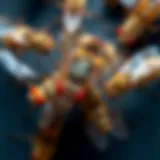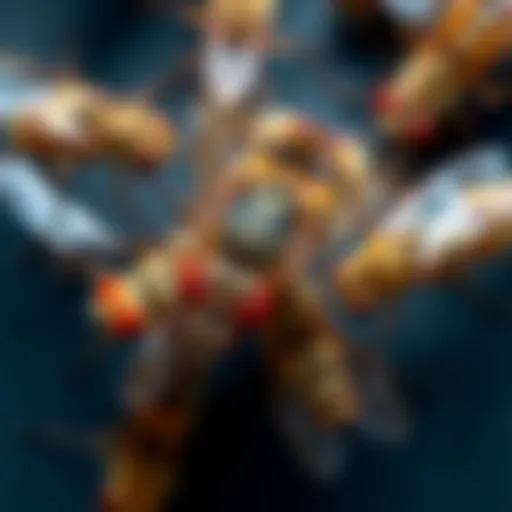Clover Mite Extermination: A Comprehensive Guide
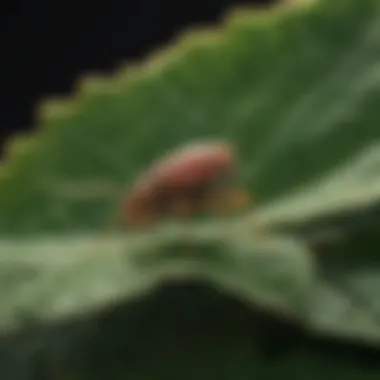

Intro
Clover mites, though small in size, can create significant disturbances in gardens and homes. Understanding their existence is crucial for homeowners seeking to maintain a serene living environment. This guide explores the essential aspects of identifying clover mites, their prevention, and effective control measures. The goal is to provide actionable insights into clover mite extermination while emphasizing environmentally friendly practices.
Pest Identification
Identifying clover mites is the first step in managing an infestation. Clover mites are tiny arachnids, usually only 1/30 of an inch long. Their most notable features are their rounded bodies and long, slender legs. The common color ranges from a bright green in the spring to a reddish-brown as they mature.
Common Household Pests
Clover mites are often confused with other small pests. It’s important for homeowners to distinguish them from similar organisms. Common household pests include:
- Spider mites
- Ticks
- Carpet beetles
To avoid misidentification, observe their movement. Clover mites tend to move quickly in a crawling manner, while other pests may not be as mobile.
Signs of Infestation
Recognizing the signs of a clover mite infestation can save time and effort in pest control. Look for:
- Tiny red or green spots on walls or furniture
- A noticeable increase in their presence near windows and doors
- Webbing or silk-like material, which suggests their nests
Monitoring these signs regularly will help in early detection, allowing for swift action.
Prevention Methods
Preventing clover mite infestations is more effective than controlling them once they arrive. There are several methods to consider.
Environmental Modifications
Adjustments in the surrounding environment can greatly reduce the likelihood of clover mites taking residence. Some strategies include:
- Removing overgrown vegetation near the house
- Trimming grass and shrubs to decrease humidity
- Using barriers such as landscaping rocks or mulch
These modifications not only create less inviting habitats for clover mites but also enhance the overall aesthetics of the outdoor space.
Home Maintenance Tips
Routine home maintenance can contribute to pest control. Here are a few tips:
- Seal cracks and crevices around the home and windows
- Keep window screens in good repair
- Regularly clean gutters and downspouts
Simple diligence can play a crucial role in clover mite management.
DIY Pest Control Solutions
When it comes to controlling clover mites, several do-it-yourself options can be effective and eco-friendly.
Natural Remedies
Utilizing natural remedies can be beneficial. Some popular choices include:
- Diatomaceous earth – Sprinkle around infested areas to deter mites.
- Soap and water solution – Spray a mixture of soap and water directly on clover mites. This can suffocate them.
- Neem oil – A natural pesticide that disrupts their lifecycle.
These methods not only tackle the problem but are also less harmful to the environment.
DIY Traps and Barriers
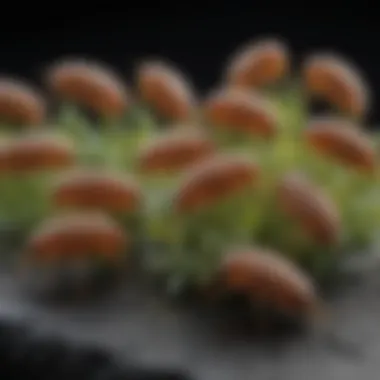

Creating physical barriers can also help in controlling clover mite populations. Consider:
- Setting up sticky traps near known infestation areas.
- Employing fine mesh netting to block entry points in windows and doors.
Implementing these strategies can reduce the chances of clover mites entering homes and gardens.
Effective pest management begins with informed decision-making and a proactive approach.
By focusing on prevention and utilizing sustainable methods, homeowners can effectively manage clover mite infestations without harming the environment.
Understanding Clover Mites
Understanding clover mites is essential for effective management and extermination. Clover mites can infiltrate homes and gardens, becoming a persistent nuisance. Recognizing their characteristics and behaviors is the first step in implementing strategies to control their populations.
Identification of Clover Mites
Clover mites are small arachnids, typically measuring around 0.75 mm in length. Their bodies are oval-shaped and can vary in color from greenish to reddish-brown depending on their environment. This variation can make them blend in or stand out against your garden flora. To accurately identify clover mites, observe them closely with a magnifying lens. They are easily mistaken for other small insects due to their size. A key feature is their long front legs, which can be several times the length of their bodies. Their presence on windowsills or exterior walls indicates an infestation.
Life Cycle of Clover Mites
Understanding the life cycle of clover mites is crucial for effective extermination efforts. They undergo a simple life cycle, consisting of four stages: egg, larva, nymph, and adult. Clover mite eggs are laid in late winter or early spring, often in protected areas, such as under leaf litter or the bark of trees. After the eggs hatch, larvae emerge, which are just six-legged versions of the adults. They grow into eight-legged nymphs before finally maturing into adults within a few weeks. Adult clover mites can reproduce rapidly, leading to significant infestations if not addressed promptly. This rapid life cycle means that pest management efforts must be timely and systematic.
Behavioral Traits
Clover mites exhibit specific behaviors that can help in their identification and management. They mainly feed on plant tissues, preferring tender young leaves, and this feeding activity can lead to visible damage on plants. Their behavior changes with temperature; during warm conditions, they may move indoors seeking cooler environments. Clover mites are also known to thrive in dry conditions, which makes gardens with insufficient moisture a prime target. When disturbed, they can quickly scurry away, making manual removal more difficult. Understanding these traits can enhance prevention methods and extermination approaches.
Clover Mite Habitat and Ecology
Understanding the habitat and ecology of clover mites is crucial for effective management. These small arachnids thrive in specific environments that influence their behavior, reproduction, and interaction with other species. By examining their preferred habitats, the impact of seasonal changes, and their relationship with other organisms, homeowners can take informed steps to control and prevent infestations. This information aids in creating effective strategies that are both efficient and considerate of the environment, aligning with the overall aim of sustainable pest management.
Preferred Environments
Clover mites prefer warm, dry areas that provide suitable conditions for their survival and reproduction. They often inhabit gardens, lawns, and near foundations of buildings. They are commonly found in grassy regions or areas where clover or other host plants, like dandelions, are present. The presence of these plants plays a significant role in attracting clover mites, as they feed primarily on their sap.
Optimal conditions include:
- Sunlight: Clover mites are often seen in sunny spots where temperatures are higher.
- Moisture Levels: While they prefer dry environments, a certain level of humidity is necessary for survival. Therefore, gardens with adequate irrigation and drainage tend to draw them in.
- Vegetative Cover: Dense vegetation offers protection and places for clover mites to reproduce.
Impact of Seasonal Changes
Seasonal changes greatly influence clover mite populations. They thrive in spring and fall when temperatures are moderate. During warmer months, populations can explode, leading to potential infestations in homes. Conversely, extreme heat can lead to decreased activity as clover mites seek cooler areas.
- Spring: As temperatures rise in spring, clover mites emerge from overwintering sites, leading to active foraging and reproduction. This is a critical time for preventive measures.
- Summer: High temperatures can reduce mite activity, but they may migrate indoors to escape harmful conditions.
- Fall: As the weather cools, populations may again spike as they seek shelter for the winter. They can be found clustering along exterior walls, windows, and doorways.
- Winter: During winter, clover mites become dormant but do not die off. It is essential to be vigilant during this time to avoid sudden population surges when temperatures rise.
Coexistence with Other Species
Clover mites do not exist in isolation; they coexist with various other species in gardens and landscapes. This interaction can have both positive and negative effects on the ecosystem.
- Beneficial Insects: They may share habitats with predatory insects, such as ladybugs and lacewings, which can help control their populations.
- Competitive Plants: Dense vegetation not only provides food but also competes for resources. This dynamic affects where clover mites can thrive.
- Parasites: Some species can parasitize clover mites, influencing their overall numbers.
Understanding these relationships can also help in pest management. Developing a diverse ecosystem can create natural checks on clover mite populations, minimizing the need for chemical pesticides.
Signs of Infestation
Recognizing the signs of clover mite infestation is critical for effective pest management. These small arachnids can quickly multiply, making early detection essential. Homeowners should be aware of the indicators that point to an infestation, as this knowledge can prevent further damage and allow for timely intervention. Identifying visual cues, understanding potential plant damage, and knowing the timing of infestations are all pivotal aspects of maintaining a healthy environment.
Visual Indicators
Clover mites are often first spotted due to their distinctive coloring and behavior. These tiny creatures are usually bright red or greenish when seen against a lighter background. The most common visual sign is small red specks moving about, often on windowsills or walls in sunny areas. They may also leave reddish stains on surfaces where they feed or crawl.


Observing them closely can provide insights into the severity of the problem. It is advisable to conduct regular inspections, especially in early spring and fall, when clover mites are more active. Keeping an eye on your home’s exterior can prevent uninvited guests from entering. Consider using a magnifying glass if needed—many homeowners report better detection with magnified views, which confirms suspicions visually.
Potential Damage to Plants
Clover mites primarily feed on small plants, grasses, and cultivated vegetation. When infestations occur, they can cause a variety of damages. Initial feeding often leads to a stippling effect on leaves, making them appear mottled or speckled. This can weaken the plant, leading to stress or even death in extreme cases.
The affect on your garden or household plants can be troubling. For example, garden flowers such as aster, and vegetables like lettuce or beans can exhibit significant impacts from large populations. Homeowners must be vigilant and check plants for these symptoms regularly to mitigate risk. Noticing early signs means you can take action before extensive damage happens, protecting both the aesthetic value of your garden and its overall health.
Timing of Infestation
Understanding the timing of clover mite infestations is crucial for effective prevention. Typically, these mites become active in early spring, when temperatures rise. They thrive in warm and dry conditions, and may become notably abundant by mid-spring. As seasons shift into fall, they seek shelter in homes, which can lead to increased indoor infestations.
Homeowners should monitor for signs of these pests during these active periods. By being aware of their life cycle, one can align preventive strategies effectively. Furthermore, while ideally one wants to prevent infestations, knowing when they are likely to occur can prepare you for prompt interventions.
By keeping a close watch on these indicators, homeowners can ensure timely response and maintain a pest-free environment.
Extermination Methods
The methods for exterminating clover mites are crucial for anyone facing an infestation, as they directly influence the effectiveness of controlling these pests. Understanding various extermination strategies aids homeowners in selecting the most suitable approach for their unique situation. Each method has its own benefits and considerations, and the right choice often depends on the extent of the infestation, the environment, and personal preferences regarding chemical use. By implementing effective extermination methods, not only can the immediate problem be addressed, but long-term control can also be achieved to reduce future infestations.
Preventive Measures
Preventive measures are essential in managing clover mites before they become a significant problem. By focusing on prevention, homeowners can reduce the likelihood of an infestation occurring in the first place. This approach is often more effective and less disruptive than responding to an existing infestation.
- Maintain Landscaping: Keeping shrubs and grass trimmed can significantly reduce the habitat for clover mites.
- Seal Entry Points: Inspect windows, doors, and other openings to ensure they are well-sealed. This reduces the chances of mites entering the home.
- Water Management: Avoid overwatering gardens, as clover mites thrive in moist conditions.
- Remove Debris: Clear away debris like leaf litter and mulch around the foundation of the home, as these can harbor mites.
- Regular Inspections: Conducting periodic checks on plants, especially during peak seasons, can help identify any early signs of mites.
Chemical Treatments
Chemical treatments can be effective in eradicating clover mite populations. However, care should be taken to choose the right product and application method due to potential environmental impacts and safety concerns. Common chemical solutions include miticides that specifically target mites while minimizing harm to other beneficial insects.
- Types of Chemicals: Look for products that contain active ingredients like bifenthrin or insecticidal soaps.
- Application Timing: Apply treatments during the early morning or late evening when clover mites are most active.
- Safety Precautions: Always follow the manufacturer’s application guidelines. Use protective gear if required and ensure proper ventilation when applying indoors.
Natural Remedies
For those who prefer a more eco-friendly approach, natural remedies offer a viable alternative. Many of these methods are less harmful to the environment and can still be effective in controlling clover mite populations.
- Water Spray: A strong spray of water can dislodge clover mites from plants, reducing their numbers.
- Soap Solutions: Mixing water with liquid soap can create an insecticidal solution. Spray the affected areas to suffocate the mites.
- Diatomaceous Earth: Apply a thin layer of diatomaceous earth in areas where clover mites are likely to be found. It acts by damaging their exoskeletons, leading to dehydration.
Professional Pest Control Services
When dealing with a severe infestation or if DIY methods fail, hiring professional pest control services can be an effective route. Professionals have access to specialized equipment, products, and techniques that can effectively manage clover mite populations.
- Assessment: Pest control professionals will assess the extent of the infestation and identify suitable treatment methods.
- Integrated Pest Management: Many professionals use an integrated pest management approach, combining various strategies for more effective results.
- Follow-Up Services: They often provide follow-up visits to ensure the problem is fully resolved, along with guidance on preventive measures.
DIY Extermination Techniques
When dealing with clover mites, employing DIY extermination techniques can greatly benefit homeowners. These methods offer a practical approach to managing infestations without relying solely on chemical treatments. The importance of these techniques lies not only in their effectiveness but also in their cost-efficiency. Homeowners often prefer DIY methods as they can implement them quickly, reducing the chance of a mite population explosion.
Understanding the various DIY options can empower individuals to take action promptly. Additionally, many home remedies utilize non-toxic ingredients, making them safe for family members and pets. However, it is essential to remember that while DIY methods can be effective, they may not eliminate the problem entirely in severe cases. A combination of several techniques can yield better results.
Home-made Solutions
Many homeowners choose home-made solutions due to their simplicity and availability of ingredients. Common solutions include soap and water mixtures. Dish soap mixed with water can suffocate clover mites upon contact. To create an effective solution, mix one to two tablespoons of mild liquid soap with a quart of water. This mixture can be sprayed directly onto infested areas, such as plants and walls.
Another popular remedy is vinegar. Vinegar's acidity can disrupt the exoskeleton of clover mites, causing dehydration. A simple solution would involve mixing equal parts of vinegar and water. This solution can also be sprayed in areas where mites are likely to thrive.
"Utilizing home-made solutions provides immediate relief and can significantly reduce mite populations when applied consistently."
Traps and Barriers
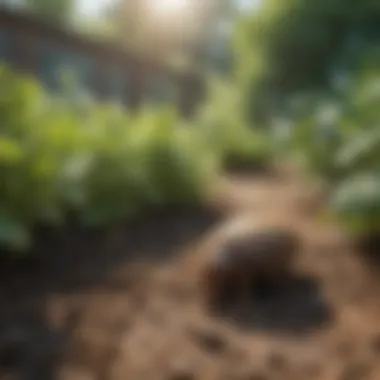

Utilizing traps and barriers proves effective in managing clover mite infestations. Sticky traps are an excellent option for monitoring and capturing mites. These traps can be placed in areas where mites are commonly seen, providing valuable information on the level of infestation. Placement near windows, doors, and indoor plants tends to yield the best results. Check the traps regularly and replace them as needed.
Physical barriers also play a critical role in prevention. Installing door sweeps and sealing cracks around windows and doors can deter mites from entering the home. Additionally, regularly cleaning the premises can help reduce the number of potential hiding spots for mites.
Monitoring and Follow-Up
Monitoring the effectiveness of your extermination techniques is crucial. After implementing any treatment, make notes about the changes in the mite population. Observing the areas where you applied home-made solutions or set traps can help you understand which tactics are working. Consistent inspection is key to catching any resurgence before it becomes a larger issue.
Follow-up actions include reapplying the solutions every few days, especially after rain or watering plants. Keeping a regular schedule can help maintain lower mite populations. If after several weeks there is no improvement, it may be time to consider professional pest control services or hybrid methods that combine DIY techniques with more robust treatments.
Sustainable Practices in Extermination
Sustainable practices in extermination are crucial in managing clover mite populations effectively without compromising environmental health. As homeowners become more aware of their ecological footprint, the demand for methods that combine efficiency with sustainability grows. Adoptining eco-friendly strategies can significantly reduce the risk of chemical exposure to humans, pets, and beneficial organisms in the garden. Sustainable practices also promote long-term pest management, ensuring that solutions are not only reactive but also preventive.
Eco-Friendly Products
Choosing eco-friendly products is essential when dealing with clover mites. Many commercial insecticides can be harmful to the environment. Instead, consider alternatives that are less hazardous. There are various natural insecticides available, such as neem oil, diatomaceous earth, and insecticidal soaps. These options target pests without leaving lingering harmful residues.
Using these products often means less aggressive application methods, which helps to preserve beneficial insects such as ladybugs and lacewings. To use eco-friendly products effectively, always read labels carefully and follow instructions. This ensures effective treatment while mitigating potential harm to the ecosystem.
Beneficial Insects and Pest Control
Utilizing beneficial insects for pest control is a sustainable method that balances the ecosystem. Introducing predators like predatory mites, ladybugs, and lacewings can help keep clover mite populations in check. These insects naturally feed on pests, thereby reducing the need for chemical interventions.
To encourage beneficial insects, it's crucial to cultivate diverse plants that provide habitats and food sources. Installing insect hotels and minimizing the use of pesticide sprays can create an environment where these helpful species thrive. A balanced ecosystem will inherently reduce the number of clover mites and other pests, leading to less reliance on artificial extermination methods.
Long-Term Prevention Strategies
Implementing long-term prevention strategies is key to sustainable clover mite management. Start by maintaining healthy soil and diverse plant life, promoting resilience against infestations. Proper watering and fertilization can strengthen plants, making them less susceptible to pests.
Here are some effective strategies:
- Ensure proper drainage to prevent standing water, which attracts pests.
- Regularly inspect plants for early signs of infestation, allowing for prompt action.
- Plant native species that are more resistant to clover mites and can support local ecosystems.
- Increase plant diversity in the garden, as monocultures attract pests more easily.
Long-term strategies create a more robust garden. They reduce the likelihood of clover mite infestations, allowing homeowners to effectively manage their gardens while adhering to sustainable practices. By integrating these techniques, one can maintain a healthy balance between pest control and environmental stewardship.
Challenges in Clover Mite Management
Managing clover mites presents significant challenges that affect both homeowners and pest control professionals. These small arachnids are remarkably resilient and exhibit behaviors that can complicate extermination efforts. Understanding these challenges is essential for developing effective strategies to manage infestations while minimizing ecological impacts.
Resistance to Treatments
Clover mites have shown an alarming capability to develop resistance to various pest control treatments. Over time, the repeated use of the same chemical agents can lead to reduced effectiveness. This resistance can complicate management efforts because what once provided effective results may no longer yield the desired outcomes. Homeowners may find themselves trapped in a cycle of trying different products, only to discover that the mite population continues to survive and thrive. This phenomenon highlights the need for diversified treatment approaches and may necessitate the integration of both chemical and non-chemical methods to overcome resistance.
Misidentification Risks
Proper identification of clover mites is crucial for effective management. Due to their small size and similarity to other pests, there is a significant risk of misidentification. This can result in incorrect treatment strategies, leading to wasted time and resources. For instance, clover mites are often confused with spider mites, which have different biological characteristics and require separate management approaches. Accurate identification can provide a clear pathway for selecting the appropriate treatment, thus increasing the chance of successful extermination. Homeowners are advised to familiarize themselves with identifying features such as color and habitat preferences.
Environmental Considerations
The environmental impact of pest control methods cannot be overlooked in the fight against clover mites. Many chemical treatments can have unintended consequences, affecting beneficial insects and overall ecosystem health. Therefore, it's imperative to consider more sustainable approaches that minimize harm to the environment. Products that are eco-friendly and methods that integrate natural predators can be more effective in long-term management without jeopardizing local ecosystems. Sustainable practices should be at the forefront of any pest management strategy, ensuring that extermination efforts do not undermine ecological integrity.
"Adopting sustainable and integrated pest management practices will lead to more effective long-term solutions against clover mites while protecting the environment."
Finale
Understanding how to manage clover mites is crucial for any homeowner or professional pest control service. This conclusion reiterates the significance of thorough knowledge regarding clover mite behavior, life cycle, and effective extermination methods. Recognizing the signs of infestation early can prevent extensive damage to gardens and homes. The strategies outlined in this article not only focus on immediate extermination but also underscore the importance of sustainable practices.
Summary of Key Points
- Clover mites are often overlooked pests that can rapidly multiply under favorable conditions.
- Identifying clover mites involves looking for their distinct red color and knowing where to find them.
- Seasonal changes can heavily influence their activity; thus, monitoring during spring and fall is vital.
- Effective extermination methods range from chemical treatments to natural remedies that are environmentally friendly.
- Long-term pest management requires a holistic approach including preventive measures and understanding cohabitation with beneficial insects.
- Recognizing the risk of misidentification can help ensure the right pest management strategies are employed.
Final Thoughts on Clover Mite Management
Management of clover mites necessitates a balanced approach embracing both effective extermination techniques and sustainable practices. Homeowners should equip themselves with knowledge about the ecology of these pests to make informed decisions. Applying eco-friendly methods can mitigate the environmental impact while effectively controlling the infestation. Continuous monitoring and adapting strategies according to the life cycle and behavior of clover mites will lead to lasting results. By following the guidelines presented, one can achieve a pest-free environment without compromising on ecological values.


